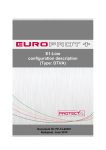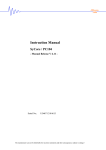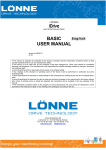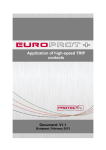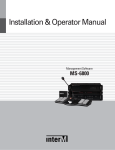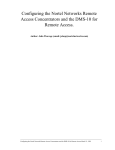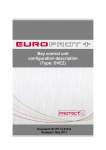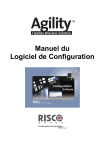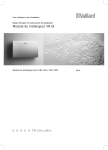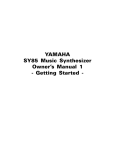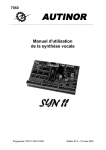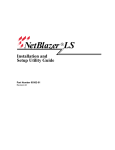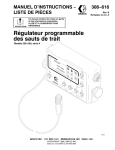Download Synchro Option Module
Transcript
Synchro Option Module SV-iS7 Series User Manual Safety Precaution Safety Precaution First thank you for using our iS7 Synchonization Option Board! Please follow the following safety attentions since they are intended to prevent any possible accident and danger so that you can use this product safely and correctly. Safety attentions may classify into ‘Warning’ and ‘Caution’ and their meaning is as following: Symbol Meaning WARNING This symbol indicates the possibility of death or serious injury. CAUTION This symbol indicates the possibility of injury or damage to property. The meaning of each symbol in this manual and on your equipment is as follows. Symbol Meaning This is the safety alert symbol. Read and follow instructions carefully to avoid dangerous situation. This symbol alerts the user to the presence of “dangerous voltage” inside the product that might cause harm or electric shock. After reading this manual, keep it in the place that the user always can contact. This manual should be given to the person who actually uses the products and is responsible for their maintenance. WARNING Do not remove the cover while power is applied or the unit is in operation. Otherwise, electric shock could occur. Do not run the inverter with the front cover removed. iii 1 Installation Conditions WARNING Otherwise, you may get an electric shock due to high voltage terminals or charged capacitor exposure. Do not remove the cover except for periodic inspections or wiring, even if the input power is not applied. Otherwise, you may access the charged circuits and get an electric shock. Wiring and periodic inspections should be performed at least 10 minutes after disconnecting the input power and after checking the DC link voltage is discharged with a meter (below DC 30V). Otherwise, you may get an electric shock. Operate the switches with dry hands. Otherwise, you may get an electric shock. Do not use the cable when its insulating tube is damaged. Otherwise, you may get an electric shock. Do not subject the cables to scratches, excessive stress, heavy loads or pinching. Otherwise, you may get an electric shock. CAUTION Be cautious when handling CMOS elements on the option board. It may cause a failure due to static electricity. When changing and connecting communication signal lines, proceed the work while the inverter is turned off. It may cause a communication error or failure. Make sure to connect the inverter body to the option board connector accurately coincided each other. It may cause a communication error or failure. Make sure to check the parameter unit when setting parameters. It may cause a communication error. iv Table of Contents Table of Contents Safety Precaution ........................................................................................................ iii Table of Contents.......................................................................................................... v 1. Installation Conditions........................................................................................ 7 2. Product Standard ................................................................................................ 8 3. Installation ......................................................................................................... 10 4. Ready for Synchronization Operation ............................................................. 12 5. Position Sync Operating................................................................................... 14 6. Speed Sync Operating ...................................................................................... 27 v 1 Installation Conditions 1. Installation Conditions Item Standard Service Temperature -10℃ ~ 50℃ Storage Temperature -20℃ ~ 65℃ Ambient Humidity Relative Humidity less than 90% RH (No condensation) Vibration Less than 1,000m, Less than 5.9m/sec2 (0.6G) Surrounding Environment No corrosive gas, flammable gas, oil mist, dust shall be inside the room. Table 1 Installationi Conditions 7 2 Product Standard 2. Product Standard RUN ERR RT_A RT_B G ETG Shield OT2 OT1 G MA_B MA_A G SL_B SL_A Item Standard How to Mount Mount it to slot 2(bottom slot) of iS7 inverter body. Master Encoder Input Maximum 100kHz The Master Encoder’s Return Pulse Output is received as Input. Slave Encoder Input Maximum 100kHz The Slave Encoder’s Return Pulse Output is received as Input. Master Encoder Return Output Maximum 100kHz The Master Encoder’s Input is outputted as Return Pulse. Terminal Block Output Output Score: 2 points Output Specification: 26V, 100mA Available slaves to be connected 15 slaves per mater Table 2 Hardware Standard Item Position Sync 8 Performance Standard Within ±5 degree, the deviation in position between the master and the slave during steady-state operating under the rated load. 2 Product Standard Item Performance Standard Speed Sync Within a bigger value between ±0.5% and ±5rpm, the deviation in speed between the master’s order speed and the slave’s current speed during steady-state operating under the rated load. 1) Table 3 Performance Standard 1) For example, if the speed of the master’s command is 1800rpm, the maximum deviation between the speed of the master’s command and the one of the slave’s command shall be within ±9rpm (=±0.5%). In addition, if the master’s command speed is 500rpm, the maximum deviation between the speed of the master’s command and the one of the slave’s command shall be within ±5rpm since ±2.5rpm (=±0.5%) is smaller than ±5rpm. Item Master Encoder Input Name MA_A Master encoder phase A input MA_B Master encoder phase B input G Slave Encoder Input Slave encoder phase A input SL_B Slave encoder phase B input Shield GND RT_A Master encoder phase A return pulse output RT_B Master encoder phase B return pulse output G Digital Output Contact GND SL_A G Master Encoder Return Pulse Output Description GND OT1 Open collector digital output contact 1 OT2 Open collector digital output contact 2 ETG Exclusive GND for digital output SHIELD Common shield line 9 3 Installation 3. Installation Step 1 Remove the cover and mount an encoder option card (slot 3) and a synchronization option card (slot 2) as seen in the figure below. But, if any inverter is used as the master for the synchronization operation, the master inverter does not need any synchronization option card to be mounted (Refer to Step 2). 2. Mount an encoder card to slot 3 3. Mount an encoder card to slot 2 1. Remove the cover Step 2 Wire the encoder option card (slot 3)and the synchronization option card (slot 2) as seen in the figure below. The following figure shows a wiring example of the case where the master motor’s encoder is of 5V line driver type and the slave motor’s encoder is of 15V open collector type. 10 3 Installation Master Inverter (Encoder Option) 5V Line driver encoder A+ A+ AB+ BGND AB+ BGND 5V 5V RT_A RT_B G Select LD 5V for the encoder option switch Select COMP, OC for the encoder option switch 15 V Open collector encoder A Slave Inverter 1 (Encoder option + Sync option) A B GND B GND 15V 15V RT_A RT_B G RT_A: Master return A pulse output RT_B: Master return B pulse output G: Ground of Master return pulse output Slave Inverter 2 (Encoder option + Synchro option) 11 4 Ready for Synchronization Operation 4. Ready for Synchronization Operation It is the way how to set the master inverter (DRV-09 Control Mode: sensored vector operating mode) and the slave inverter (DRV-09 Control Mode: sensored vector operating mode) and tune the motor before operating the speed (or position) synchronization. Step 1. Check the motor’s rotating direction a. Set DRV-01 Cmd Frequency to a low speed (10Hz or below) and set DRV-06 Cmd Source to Keypad. b. Set DRV-09 Control Mode to V/F and make a forward command with keypad and check if plus (+) value is read when monitoring APO-08 Enc Monitor. c. If it is minus (-) value, change the setting of APO-05 Enc Pulse Sel to –(A + B). Step 2. Set the encoder option a. Set APO-01 Enc Opt Mode to Feedback. b. Input APO-06 Enc Pulse Num into the Encoder pulse Standard (E.g. 1024). c. Set DRV-09 Control Mode to Vector (sensored vector operating mode). d. Set DRV-06 Cmd Source (operating command source), DRV-07 Freq Ref Src (Frequency command source), DRV-03 Acc Time (acceleration time) and DRV-04 Dec Time (deceleration time) respectively. Step 3. Master/Slave Motor tuning a. Read the Motor’s nameplate to input BAS-11 Pole Number (number of motors’ pole), BAS-12 Rated Slip (Motor rated slip RPM), BAS-13 Rated Curr (Motor rated current), BAS-15 Rated Volt (Motor rated voltage), BAS16 Efficiency (Motor efficiency) and BAS-19 AC Input Volt (inverter Input voltage). b. You may select All (rotating tuning) or All StdStl (static tuning) from BAS20 Auto Tuning. In case that the motor cannot be rotated during the tuning because of excessive load is placed to the motor, select All StdStl (static tuning). However, rotating tuning shows relatively better performance than static tuning and any value close to actual motor integral shall be calculated. 12 4 Ready for Synchronization Operation Step 4. Set the external break control function If BR Control is set from OUT-31~32(Relay1, 2) and OUT-33(Q1 Define), it is possible to use an applicable contact output as external break control. For external break control function, set the function from ADV-41(BR Rls Curr)~ADV-47(BR Eng Fr). Step 5. Set the synchronization operating mode (Applicable only to slave inverters) Set APP-01 App Mode to Synchro. Henceforth, you may select a relevant parameter to synchronization operating from SYN Group. Step 6. Check the direction of Encoder pulse of the master/slave inverter Especially, for position sync operating, the direction of the master inverter and that of the slave inverter shall be corresponding. Here, it is assumed that it rotates counterclockwise (CCW) when APO-08 Enc Monitor pulse increases (+) and the motor axis is seen from the front during the forward (FWD) operating. a. Set SYN-21 Sync Mode to 0: SPD Ctrl for the slave inverter. Forward (FWD) operating command shall be simultaneously made in low speed of approximately 5Hz for the master and slave inverter. When monitoring the pulse of the Slave inverter’s APO-08 Enc Monitor, check if the pulse increases. If it decreases, exchange MA_A with MA_B and vice versa in the applicable Slave Synchronization option terminal block wiring. 13 5 Position Sync Operating 5. Position Sync Operating The master’s load axis position and many slaves’ load axis position are synchronized to operate. The master inverter does not need any synchronization option card while the slave inverter uses synchronization option cards to follow the master inverter position. Since the slave follows the master’s encoder position pulse, the Position Sync operating needs to be much more sophisticate than the Speed Sync operating. In actual, the slave inverter is controlled when the deviation between the master and the slave position is within about 2 degree (= Pi/90 rad) during 1800rpm steady-state operating. 14 Group No Function Display Setting Value Setting Range Unit SYN 01 Sync S/W Ver Read only - - SYN 02 Sync LED Stat Read only - - SYN 03 Sync DO Stat Read only - - SYN 07 Master Speed Read only - rpm SYN 08 Slave Speed Read only - rpm SYN 11 Master Pulse H Read only - Hex SYN 12 Master Pulse L Read only - Hex SYN 13 Slave Pulse H Read only - Hex SYN 14 Slave Pulse L Read only - Hex SYN 15 M/S Pulse Dev Read only - - SYN 17 Comm Err Cnt Read only - - SYN 21 Sync Mode 0 : SPD Ctrl SYN 22 M Enc Pulse No 1024 360~4096 - SYN 23 S Enc Pulse No 1024 360~4096 - SYN 25 Slave Dir 0 : Forward 0 : SPD Ctrl 1 : POS Ctrl 0 : Forward 1 : Reverse - 5 Position Sync Operating Group No Function Display Setting Value Setting Range Unit SYN 31 SPD Lpf Gain 10 0~30000 ms SYN 32 SPD Limit 1800 100~3600 rpm SYN 33 POS FF Gain 100.0 0.0~3000.0 % SYN 35 POS P Gain 100.0 0.0~3000.0 % SYN 36 POS I Gain 0.0 0.0~3000.0 sec SYN 37 POS D Gain 0 0~10000 ms SYN 38 POS I Limit 2.0 0.0~100.0 % SYN 39 POS PIDout Scl 100.0 0.0~1000.0 % SYN 40 POS PIDout LPF 5 0~10000 ms SYN 41 POS PID sRampT 0.0 0.0~1000.0 sec SYN 42 PID Limit 20.0 0.0~1000.0 % SYN 45 POS PI Type 0 : Fixed SYN 46 POS PropPI Min 10.0 0.0~1000.0 % SYN 49 M Gear Multi 1 1~30000 - SYN 50 M Gear Div 1 1~30000 - SYN 51 S Gear Multi 1 1~30000 - SYN 52 S Gear Div 1 1~30000 - SYN 58 POS Det Level 100 0~65535 pulses SYN 59 POS Det DelayT 1.00 0.00~300.00 sec SYN 65 Hold Speed 3.00 0.00~maxFreq Hz SYN 70 Sync Acc Time 0.1 0.0~100.0 sec SYN 71 Sync Dec Time 0.1 0.0~100.0 sec - - 65 IN ~ 72 0 : Fixed 1 : Proportional - Sync Disable Px Define Sync Hold 15 5 Position Sync Operating SYN-21 Sync Mode If 1 POS Ctrl is selected, it is operated in the Position Sync operating. The Position Sync operating is the one in which the slave follows the master’s encoder position pulse. The entire block diagram is as following: 16 5 Position Sync Operating 17 5 Position Sync Operating SYN-22 M Enc Pulse No SYN-23 S Enc Pulse No Input the master and slave encoder’s ‘Pulses/1 rev’ respectively. SYN-25 Slave Dir Set the operating direction of the slave motor. The final operating direction of the Slave Motor depends on a. The master’s operating direction b. The slave’s direction command c. SYN25 Slave Dir Setting Value Master operating command Slave operating command SYN25 Slave Dir Slave Motor Final operating direction Forward Forward Forward Forward Forward Forward Reverse Reverse Forward Reverse Forward Reverse Forward Reverse Reverse Forward Reverse Forward Forward Reverse Reverse Forward Reverse Forward Reverse Reverse Forward Forward Reverse Reverse Reverse Reverse SYN-31 SPD Lpf Gain The Return Pulse Output of the master inverter will be inputted as the master pulse of the slave inverter’s synchronization option card. It is possible to set low-pass filter gain for the speed (rpm) decided by its master pulse and make it less sensitive to noise. As a bigger value is given, the effect of removing noise becomes more significant but, the speed response of the save inverter becomes lower. 18 5 Position Sync Operating During the Position Sync operating, the master speed (rpm) that has been low-pass filtered is the input of SYN-33 POS FF Gain, the position controller’s feed forward gain. SYN-32 SPD Limit It limits to the slave inverter’s output speed(rpm). SYN-33 POS FF Gain It is the position controller’s feed forward gain. By forward compensating the master’s current speed, it can increase the response of the Position Sync operating. SYN-35 POS P Gain SYN-36 POS I Gain SYN-37 POS D Gain It is the PID controller’s P/I/D gain for Position Sync. SYN-38 POS I Limit It limits the PID controller’s Output for Position Sync as the following equation. Therefore, any wind-up due to integral operation can be prevented. Gear ratio of the master' s side = 22175 SYN − 49 M Gear Multi 38.2 19.2 = × = 2.2175 = 10.5 31.5 10000 SYN − 50 M Gear Div SYN-39 POS PIDout Scl It adjusts the position PID controller’s output scale. If 100% is set, 100% of the position PID controller Output while only 10% of the position PID controller Output will be outputted if 10% is set. SYN-40 POS PIDout LPF It is possible to set low pass filter gain to the position PID controller Output. As a bigger set value is given, the position PID controller Output will become more stable but, its response will be lower. Except special cases, set it to an appropriate value(Less than about 50ms). 19 5 Position Sync Operating SYN-41 POS PID sRampT It is possible to mitigate a transitional phenomenon in starting by gradually increasing or decreasing the position PID controller’ Output during the SYN-41 POS PID sRampT time when starting the slave inverter. SYN-42 PID Limit It limits the Position Sync PID controller’s Output. It is percentage against the speed[rpm] set from SYN-32 SPD Limit. SYN-45 POS PI Type SYN-46 POS Prop PI Min SYN-45 POS PI Type “0 Fixed”: Regardless of the current speed, the PID controller’s Output for Position Sync is always fixed constantly . SYN-45 POS PI Type “1 Proportional”: As speed is lower, the PID controller’s Output is reduced proportionally. Since the PID controller’s Output becomes excessively lower in low speed, limit to the minimum value of the PID controller to SYN-46 POS Prop PI Min . SYN-49 M Gear Multi SYN-50 M Gear Div SYN-51 S Gear Multi SYN-52 S Gear Div 20 5 Position Sync Operating 21 5 Position Sync Operating Input the gear ratio of the master/slave side respectively. As seen in the figure, the first stage gear ratio of the master side is 38.2: 10.5, and its second stage of belt ratio is 19.2: 31.5. Therefore, the gear ratio of the master side can be calculated as following: Gear ratio of the master' s side = 22175 SYN − 49 M Gear Multi 38.2 19.2 = × = 2.2175 = 10000 SYN − 50 M Gear Div 10.5 31.5 Input 22175 for SYN-49 M Gear Multi and 10000 for SYN-50 M Gear Div. In the same way, the gear ratio of the slave side is 29.5: 22.5 as seen in the figure. Therefore the gear ratio of the slave side can be calculated as following: Gear ratio of the slave's side = 295 SYN − 51 S Gear Multi 29.5 = = 22.5 225 SYN − 52 S Gear Div Input 295 for SYN-51 S Gear Multi and 225 for SYN-52 S Gear Div. 22 5 Position Sync Operating SYN-03 Sync DO Stat SYN-58 POS Det Level SYN-59 POS Det DelayT If the deviation between the master motor’s load axis and the slave motor’s load axis pulse remains within SYN-58 POS Det Level for SYN-59 POS Det DelayT time, Open Collector Digital Output Contact 2(terminal block OT2-ETG in the figure below) will be turned ON. Encoder Pulse Master Slave It is possible to monitor the state of Open Collector Digital Output Contact 2 from SYN-03 Sync DO Stat as seen inside of a dotted line of the following figure. Open Collector Digital Output Contact 2 ON : Open Collector Digital Output Contact 2 OFF : SYN-70 Sync Acc Time SYN-71 Sync Dec Time It is a seperate accelerating/decelerating time dedicated to synchronization operating. As a bigger time is given, the response of synchronization operating becomes slower and its performance is deteriorated. Except special cases, it is better to set a short time. 23 5 Position Sync Operating IN-65~72 Px Define: Sync Disable If any Function Input that has been set to Sync Disable is turned On, Synchronization operating will be prohibited. DRV04 Dec Time (Condition other than multi-stage acceleration/deceleration ) SYN70 Sync Acc Time Run Speed DRV01 Cmd Frequency (Velocity order is keypad and it is not multi-stage velocity Condition other than multi-stage velocity) Sync Disable Master Slave IN-65~72 Px Define: Sync Hold SYN-65 Hold Speed 24 5 Position Sync Operating IN-65~72 Px Define: Sync Reset SYN-75 Sync Reset It is possible to initialize both of the master’s Return Pulse and the slave’s Return Pulse to be inputted to the Slave inverter to 0. Turn on the inverter’s multi-function Input Sync Reset or answer Yes to SYN-75 Sync Reset condition. After initializing the master/slave pulse, make sure to turn the multifunction Input Sync Reset Off and set SYN-75 Sync Reset to No to perform Position Sync operating. Position Pulse Save Function Save the master and slave’s position pulse (32bit) respectively. Therefore, it is possible to restart Position Sync operating from the previous position when recovering the power. SYN-07 Master Speed SYN-08 Slave Speed It is possible to monitor the master and slave load axis’s speed respectively. SYN-11 Master Pulse H SYN-12 Master Pulse L It is possible to monitor the master load axis’s current pulse. SYN11 Master Pulse H shows higher 16bit and SYN-12 Master Pulse L shows lower 16bit. SYN-13 Slave Pulse H SYN-14 Slave Pulse L It is possible to monitor the slave load axis’s current pulse. SYN-13 Slave Pulse H shows higher 16bit and SYN-14 Slave Pulse L shows lower 16bit. SYN-15 M/S Pulse Dev It is possible to monitor the deviation between the master load axis’s current pulse and the slave load axis’s current pulse. 25 5 Position Sync Operating For example, if SYN-15 M/S Pulse Dev is ±11 from1024 pulses/rev Encoder, it means ±1 degree (=pi/360 [rad]) of error. SYN-01 Sync S/W Ver It refers to synchronization option card S/W version. SYN-02 Sync LED Stat It shows the state of Synchronization option card’s RUN LED, ERR LED. If RUN LED is flickering in 1-second interval and ERR LED is turned off, it means it is running normally. Even though RUN LED is flickering in 1-second interval and ERR LED is flickering in a fast interval (about 400ms), it shows that any error takes place when exchanging data between the inverter body and the synchronization option card. SYN-17 Comm Err Cnt It counts the number of errors that take place when receiving and sending data between iS7 inverter body and Synchronization option card. If any value other than 0 is displayed, stop operating and check the inverter body and the synchronization option card for the connection between them. 26 6 Speed Sync Operating 6. Speed Sync Operating The master’s load axis and a number of slave load axes are synchronized and operated under the same speed. The master inverter does not need any synchronization option card but the slave inverter uses the synchronization option card to follow the master inverter’s speed. Group No Function Display Setting Value Setting Range Unit SYN 01 Sync S/W Ver Read only - - SYN 02 Sync LED Stat Read only - - SYN 03 Sync DO Stat Read only - - SYN 07 Master Speed Read only - rpm SYN 08 Slave Speed Read only - rpm SYN 17 Comm Err Cnt Read only - - SYN 21 Sync Mode 0 : SPD Ctrl SYN 22 M Enc Pulse No 1024 360~4096 - SYN 23 S Enc Pulse No 1024 360~4096 - SYN 25 Slave Dir 0 : Forward SYN 31 SPD Lpf Gain 10 0~30000 ms SYN 32 SPD Limit 1800 100~3600 rpm SYN 49 M Gear Multi 1 1~30000 - SYN 50 M Gear Div 1 1~30000 - SYN 51 S Gear Multi 1 1~30000 - SYN 52 S Gear Div 1 1~30000 - SYN 53 S SPD Multi 1 1~30000 - SYN 54 S SPD Div 1 1~30000 - SYN 56 SPD Det Level 20.0 0.0~1000.0 rpm 0 : SPD Ctrl 1 : POS Ctrl 0 : Forward 1 : Reverse - 27 6 Speed Sync Operating Group No Function Display Setting Value Setting Range Unit SYN 57 SPD Det DelayT 1.00 0.00~300.00 sec SYN 65 Hold Speed 3.00 0.00~maxFreq Hz SYN 70 Sync Acc Time 0.1 0.0~100.0 sec SYN 71 Sync Dec Time 0.1 0.0~100.0 sec - - IN 65 ~72 Sync Disable Px Define Sync Hold SYN-21 Sync Mode If SPD Ctrl is selected, Speed Sync operating will be carried out. The entire block diagram is as following: 28 M Enc Pulse No Setting Value S Enc Pulse No Slave Speed Calculation Slave Encoder Pulse Input SYN23 Master Speed Calculation Setting Value SPD Lpf Gain Setting Value Master Encoder Pulse Input SYN31 SYN22 M Gear Multi Setting Value S Gear Div Setting Value S Gear Multi Setting Value M Gear Div Setting Value SYN54 SYN53 S SPD Multi Setting Value S SPD Div Setting Value M Gear Multi Setting Value M Gear Div Setting Value SYN52 SYN51 Setting Value S Gear Div Setting Value S Gear Multi SYN 51 S Gear Multi SYN 52 S Gear Div SYN50 SYN49 SYN 49 M Gear Multi SYN 50 M Gear Div - + Master Speed Read Only SYN08 SYN57 SYN56 Read Only Slave Speed Setting Value SPD Det DelayT Setting Value SPD Det Level Speed Sync Completed SYN07 SYN 49 M Gear Multi SYN 52 S Gear Div SYN 53 S SPD Multi × × SYN 50 M Gear Div SYN 51 S Gear Multi SYN 54 S SPD Div SYN52 SYN51 SYN50 SYN49 SYN32 Sync Dec Time SYN65 Hold Speed Setting Value Normal Operation Slave Dir Forward 1 : Position Sync Operation 2 : Sync Disable Multi-function Input On 3 : Sync Hold Multi-function Input On Setting Value Sync Option Digital Output 1 (OT1-ETG) On Setting Value Sync Acc Time Setting Value SPD Limit SYN71 SYN70 -1 1 SYN25 3 2 1 Inverter Speed Command (Slave) 6 Speed Sync Operating 29 6 Speed Sync Operating SYN-22 M Enc Pulse No SYN-23 S Enc Pulse No Input the master and slave encoder’s pulses/1 rev respectively. SYN-25 Slave Dir Refer to page 18. SYN-31 SPD Lpf Gain The master inverter’s Return Pulse Output is inputted as the master pulse of this slave inverter’s synchronization option card. It is possible to set low pass filter gain to that master pulse to make it less sensitive to noise. As a bigger set value is given, the response of the slave inverter’s speed becomes lower even though the effect to remove noise is remarkable. SYN-32 SPD Limit It can limit the slave inverter’s Output speed(rpm). SYN-49 M Gear Multi SYN-50 M Gear Div SYN-51 S Gear Multi SYN-52 S Gear Div Refer to page 20~22. SYN-53 S Spd Multi SYN-54 S Spd Div The slave motor’s speed gain shall be setted. For example, if SYN-53 S Spd Multi and SYN-54 S Spd Div are 1 respectively regardless of the master/slave gear ratio, Speed Sync operating can be performed while the master motor’s load axis is operating in 500rpm and the slave motor’s load axis is also operating in 500rpm. 30 6 Speed Sync Operating At this time, if SYN-53 S Spd Multi is set to 1000 and SYN-54 S Spd Div is set to 900, the final speed of the slave motor’s load axis will be decided as following: Open Collector Digital Output Contact 1 ON : Open Collector Digital Output Contact 1 OFF : SYN-70 Sync Acc Time SYN-71 Sync Dec Time Refer to page 23. 31 6 Speed Sync Operating IN-65~72 Px Define : Sync Disable Refer to page 24. IN-65~72 Px Define : Sync Hold SYN-65 Hold Speed Refer to page 24. SYN-07 Master Speed SYN-08 Slave Speed It is possible to monitor the master and slave load axis’s speed respectively. SYN-01 Sync S/W Ver SYN-02 Sync LED Stat Refer to page 26. 32 10310001151 ■ ■ HEAD OFFICE Address: LS tower, 1026-6, Hogye-dong, Dongan-gu, Anyang-si, Gyeonggi-do 431-848, Korea http://eng.lsis.biz ■ LS Industrial Systems Europe B.V >> Amsterdam, Netherland st ■ Address: 1 FL., Tupolevlaan 48, 1119NZ Schiphol-Rijk, The Netherlands Tel: 31-20-654-1420 Fax: 31-20-654-1429 e-mail: [email protected] ■ LS Industrial Systems (Middle East) FZE Office >> Dubai, UAE Address: LOB 19 Jafza View Tower Room 205, Jebel Ali Free Zone, ■ P.O.Box 114216, Dubai, UAE. Tel: 971-4-886-5360 Fax: 971-4-886-5361 e-mail: [email protected] ■ Dalian LS Industrial Systems Co., Ltd, >> Dalian, China Address: No. 15 Liaohexi 3-Road, Economic and Technical Development ■ Zone, Dalian 116600, China Tel: 86-411-8273-7777 Fax: 86-411-8730-7560 e-mail: [email protected] ■ LS Industrial Systems Wuxi Co., Ltd. >> Wuxi, China Address: 102-A National High & New Tech Industrial Development Area, ■ Wuxi, Jiangsu 214028, China Tel: 86-510-8534-6666 Fax: 86-510-522-4078 e-mail: [email protected] ■ LS-VINA Industrial Systems Co., Ltd. >> Hanoi, Vietnam Address: Nguyen Khe, Dong Anh, Ha Noi, Vietnam Tel: 84-4-882-0222 Fax: 84-4-882-0220 e-mail: [email protected] ■ ■ LS-VINA Industrial Systems Co., Ltd. >> Hochiminh, Vietnam Address: 41 Nguyen Thi Minh Khai Str. Yoco Bldg 4 th FL., Hochiminh City, Vietnam Tel: 84-8-3822-7941 Fax: 84-4-3822-7942 e-mail: [email protected] LS Industrial Systems Tokyo Office >> Tokyo, Japan Address: 16th FL., Higashi-Kan, Akasaka Twin Tower 17- 22, 2-chome, Akasaka, Minato-ku, Tokyo 107-8470, Japan Tel: 81-3-3582-9128 Fax: 81-3-3582-2667 e-mail: [email protected] LS Industrial Systems Shanghai Office >> Shanghai, China Address: Room E-G, 12th FL., Huamin Empire Plaza, No. 726, West Yan’an Road, Shanghai 200050, China Tel: 86-21-5237-9977 (609), FAX: 89-21-5237-7191 e-mail: [email protected] LS Industrial Systems Beijing Office >> Beijing, China Address: B-tower 17th FL., Beijing Global Trade Center B/D, No.36, BeiSanHuanDong-Lu, DongCheng-District, Beijing 100013, China Tel: 86-10-5825-6025, 7 Fax: 86-10-5825-6026 e-mail: [email protected] LS Industrial Systems Guangzhou Office >> Guangzhou, China Address: Room 1403, 14th FL., New Poly Tower, 2 Zhongshan Liu Road, Guangzhou, China Tel: 86-20-8326-6764 Fax: 86-20-8326-6287 e-mail: [email protected] LS Industrial Systems Chengdu Office >> Chengdu, China Address: 12th FL., Guodong Building, No.52 Jindun Road, Chengdu, 610041, P.R. China Tel: 86-28-8612-9151 Fax: 86-28-8612-9236 e-mail: [email protected] LS Industrial Systems Qingdao Office >> Qingdao, China Address: 7B40, Haixin Guangchang Shenye B/D B, No.9, Shandong Road, Qingdao 26600, China Tel: 86-532-8501-6568 Fax: 86-532-583-3793 e-mail: [email protected] ■ 본사 (Drive 사업부): 경기도 안양시 동안구 호계동 1026-6 LS타워 B/D (우)431-080 ■ 구입 문의 서울영업 부산영업 대구영업 서부영업 (광주) 서부영업 (대전) 서부영업 (전주) TEL: (02)2034-4611~18 TEL: (051)310-6855~60 TEL: (053)603-7741~7 TEL: (062)510-1885~91 TEL: (042)820-4240~42 TEL: (063)271-4012 FAX: FAX: FAX: FAX: FAX: FAX: (02)2034-4622 (051)310-6851 (053)603-7788 (062)526-3262 (042)820-4298 (063)271-2613 ■ 기술문의 고객상담센터 동현산전(안양) 나노오토메이션(대전) 신광ENG(부산) 씨에스티(부산) 에이엔디시스템(부산) TEL: (전국어디서나) 1544-2080 FAX: TEL: (031)479-4785~6 FAX: TEL: (042)636-8015 FAX: TEL: (051)319-1051 FAX: TEL: (051)311-0337 FAX: TEL: (051)317-1237 FAX: (041)550-8600 (031)479-4784 (042)636-8016 (051)319-1052 (051)311-0338 (051)317-1238 ■ 교육신청 연락처: LS산전 연수원 TEL: (043)268-2631~2 서울 교육장 TEL: (031)689-7101 부산 교육장 TEL: (051)310-6860 대구 교육장 TEL: (053)603-7744 FAX: (043)268-4384 FAX: (031)689-7113 FAX: (051)310-6851 FAX: (053)603-7788 ⓒ LS Industrial Systems Co., Ltd 2011 All Rights Reserved. ■ A/S 문의 서울 고객지원팀 천안 고객지원팀 부산 고객지원팀 대구 고객지원팀 광주 고객지원팀 ■ 서비스 지정점 명산전(서울) TPI시스템(서울) 신진시스템(안산) 우진산전(의정부) 성원M&S(인천) 태영시스템(대전) 파란자동화(천안) 디에스산전(청주) 지이티시스템(구미) 대명시스템(대구) 서진산전(울산) 동남산전(창원) 정석시스템(광주) 코리아산전(익산) TEL: TEL: TEL: TEL: TEL: TEL: TEL: TEL: TEL: TEL: TEL: TEL: TEL: TEL: TEL: TEL: TEL: TEL: TEL: (031)689-7112 FAX: (031)689-7113 (041)550-8308~9 FAX: (041)554-3949 (051)310-6922~3 FAX: (051)310-6851 (053)603-7751~4 FAX: (053)603-7788 (062)510-1883,92 FAX: (062)526-3262 (02)462-3053 (02)895-4803~4 (031)508-9606 (031)877-8273 (032)588-3750 (042)670-7363 (041)579-8308 (043)237-4816 (054)465-2304 (053)564-4370 (052)227-0335 (055)265-0371 (062)526-4151 (063)835-2411~5 FAX: FAX: FAX: FAX: FAX: FAX: FAX: FAX: FAX: FAX: FAX: FAX: FAX: FAX: (02)462-3054 (02)6264-3545 (031)508-9608 (031)878-8279 (032)588-3751 (042)670-7364 (041)579-8309 (043)237-4817 (054)465-2315 (053)564-4371 (052)227-0337 (055)265-0373 (062)526-4152 (063)831-1411 SV-iS7 Series /2011.01



































